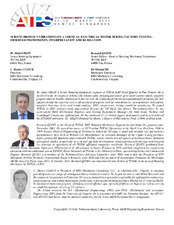| dc.description.abstract | During the factory tests of a vertical electric driven de-ballasting pump, casing vibrations were observed on the motor above the contractual limit of 2.8 mm/s, mainly on the motor’s top, Non-Drive End. Supported by fluid film journal bearings, this motor is cooled and lubricated by a low viscosity fluid in which the entire rotor assembly is submerged. A spectrum analysis revealed that the dominant vibration was a subsynchronous component near 12.5 Hz, corresponding to half of the rotating frequency. However, the motor was not equipped with proximity probes and therefore no information on the shaft vibrations was available. Initial investigations included geometrical and dimensional checks which did not reveal any evidence of defects. A modal analysis of the motor casing, both theoretical and experimental, confirmed the location of the casing’s reed frequency mode at approximately 12.5 Hz. Given these modal testing results, the motor was retested with additional bracing located on the Non-Drive End side (top of the motor). The vibrations amplitude decreased, but was still present. The motor was then equipped with proximity probes to measure the relative displacement at both shaft ends. Results clearly showed very high vibrations displacement of 200µm p-p at exactly half of the rotating frequency, whatever the speed, and these levels represented around 90% of the bearings clearance! With these test results, it became clear that the root cause of the casing subsynchronous vibrations was a rotor whirl instability exciting the motor’s reed frequency mode. This paper will describe a detailed rotordynamics analysis from which the results indicated the presence of two rotor modes very close in frequency and tracking the half running speed, predicted to be unstable whatever the speed, confirming the observed fluid whirl phenomenon with amplitudes largely exceeding API vibration criteria. For historical reference and interest, thirty years ago, Ed Gunter was involved in fixing vertical pumps for the US Navy that used plain journal bearings and consequently whirled [1]. Modifications to the bearings design appeared then to be mandatory, which will be described in the paper, including a detailed rotordynamics comparative analysis between the two configurations. Finally, both the analysis results and the tests results with these modified bearings proved to be fully consistent and eventually solved the initial observed subsynchronous shaft instability. | en |


